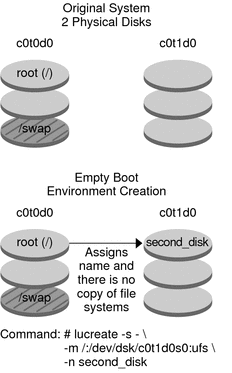Example of Creating an Empty Boot Environment and Installing a Solaris Flash Archive
The following procedures cover the three-step process:
The lucreate command creates a boot environment that is based on the file
systems in the active boot environment. When you use the lucreate command with
the -s - option, lucreate quickly creates an empty boot environment. The
slices are reserved for the file systems specified, but no file systems are
copied. The boot environment is named, but not actually created until installed with
a Solaris Flash archive. When the empty boot environment is installed with an
archive, file systems are installed on the reserved slices. The boot environment is
then activated.
To Create an Empty Boot Environment
In this first step, an empty boot environment is created. Slices are reserved
for the file systems that are specified, but no copy of file
systems from the current boot environment occurs. The new boot environment is named
second_disk.
# lucreate -s - -m /:/dev/dsk/c0t1d0s0:ufs \ -n second_disk
The boot environment is ready to be populated with a Solaris Flash
archive.
Figure 10-3 shows the creation of an empty boot environment.
Figure 10-3 Creating an Empty Boot Environment

To Install a Solaris Flash Archive on the New Boot Environment
In this second step, an archive is installed on the second_disk boot environment
that was created in the previous example. The archive is located on the
local system. The operating system versions for the -s and -a options
are both Solaris Express 5/07 releases. The archive is named Solaris_11.flar.
# luupgrade -f -n second_disk \ -s /net/installmachine/export/Solaris_11/OS_image \ -a /net/server/archive/11.flar
The boot environment is ready to be activated.
To Activate the New Boot Environment
In this last step, the second_disk boot environment is made bootable with the
luactivate command. The system is then rebooted and second_disk becomes the active boot environment.
# luactivate second_disk
# init 6
